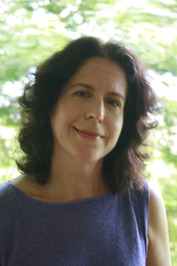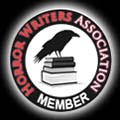Here is the final ballot, and this year is going to be a doozy with Stephen King and his son Joe Hill Squaring off for the main prize.
Also of note, in the YA category, 2 books I have been a big champion of, Cat Winters' In the Shadow of Blackbirds is up against Geoffrey Girard’s Project Cain.
I am very impressed this the quality of nominees this year. The full ballot is at this link and posted below. Congrats to all of the nominees.
The Horror Writers Association (HWA) is pleased to announce the Final Ballot for the 2013 Bram Stoker Awards®. The HWA (see WWW.HORROR.ORG ) is the premiere writers organization in the horror and dark fiction genre, with over 1,200 members. HWA has presented the Bram Stoker Awards in various categories since 1987 (see HTTP://WWW.HORROR.ORG/AWARDS/STOKERS.HTM).
“We are proud to present a particularly notable slate of nominees this year, showing the horror genre is strong and popular,” Rocky Wood, the HWA’s President, said.
IMPORTANT: Voting begins on 2/28 and ends on 3/15. Only Active and Lifetime members can vote.
The nominees are:
Superior Achievement in a Novel
• Joe Hill – NOS4A2 (William Morrow)
• Stephen King – Doctor Sleep (Scribner)
• Lisa Morton – Malediction (Evil Jester Press)
• Sarah Pinborough and F. Paul Wilson – A Necessary End (Thunderstorm/Maelstrom Press)
• Christopher Rice – The Heavens Rise (Gallery Books)
Superior Achievement in a First Novel
• Kate Jonez – Candy House (Evil Jester Press)
• John Mantooth – The Year of the Storm (Berkley Trade)
• Rena Mason – The Evolutionist (Nightscape Press)
• Jonathan Moore – Redheads (Samhain Publishing)
• Royce Prouty – Stoker’s Manuscript (G.P. Putnam’s Sons)
Superior Achievement in a Young Adult Novel
• Patrick Freivald – Special Dead (JournalStone)
• Kami Garcia – Unbreakable (Little, Brown Books for Young Readers)
• Geoffrey Girard – Project Cain (Simon & Schuster Books for Young Readers)
• Joe McKinney – Dog Days (JournalStone)
• Cat Winters – In the Shadow of Blackbirds (Harry N. Abrams)
Superior Achievement in a Graphic Novel
• Ed Brubaker – Fatale Book Three: West of Hell (Image Comics)
• Caitlin R. Kiernan – Alabaster: Wolves (Dark Horse Comics)
• Brandon Seifert – Witch Doctor, Vol. 2: Mal Practice (Image Comics)
• Cameron Stewart – Sin Titulo (Dark Horse Comics)
• Paul Tobin – Colder (Dark Horse Comics)
Superior Achievement in Long Fiction
• Dale Bailey – “The Bluehole” (The Magazine of Fantasy & Science Fiction, May/June 2013)
• Gary Braunbeck – “The Great Pity” (Chiral Mad 2, Written Backwards)
• Benjamin K. Ethridge – “The Slaughter Man” (Limbus, Inc., JournalStone)
• Gregory Frost – “No Others Are Genuine” (Asimov’s Science Fiction, Oct./Nov. 2013)
• Greg F. Gifune – House of Rain (DarkFuse)
• Rena Mason – East End Girls (JournalStone)
Superior Achievement in Short Fiction
• Michael Bailey – “Primal Tongue” (Zippered Flesh 2, Smart Rhino Publications)
• Patrick Freivald – “Snapshot” (Blood & Roses, Scarlett River Press)
• David Gerrold – “Night Train to Paris” (The Magazine of Fantasy & Science Fiction, Jan./Feb. 2013)
• Lisa Mannetti – “The Hunger Artist” (Zippered Flesh 2, Smart Rhino Publications)
• John Palisano – “The Geminis” (Chiral Mad 2, Written Backwards)
• Michael Reaves – “Code 666” (The Magazine of Fantasy & Science Fiction, March/April 2013)
Superior Achievement in a Screenplay
• Fabien Adda and Fabrice Gobert – The Returned: “The Horde” (Ramaco Media I, Castelao Pictures)
• Brad Falchuk – American Horror Story: Asylum: “Spilt Milk” (Brad Falchuk Teley-Vision, Ryan Murphy Productions)
• Bryan Fuller – Hannibal: “Apéritif” (Dino De Laurentiis Company, Living Dead Guy Productions, AXN: Original X Production, Gaumont International Television)
• Daniel Knauf – Dracula: “A Whiff of Sulfur” (Flame Ventures, Playground, Universal Television, Carnival Films)
• Glen Mazzara – The Walking Dead: “Welcome to the Tombs” (AMC TV)
Superior Achievement in an Anthology
• R.J. Cavender and Boyd E. Harris (ed.) – Horror Library: Volume 5 (Cutting Block Press)
• Eric J. Guignard (ed.) – After Death… (Dark Moon Books)
• Michael Knost and Nancy Eden Siegel (ed.) – Barbers & Beauties (Hummingbird House Press)
• Joseph S. Pulver, Sr. (ed.) – The Grimscribe’s Puppets (Miskatonic River Press)
• Anthony Rivera and Sharon Lawson (ed.) – Dark Visions: A Collection of Modern Horror, Volume One (Grey Matter Press)
Superior Achievement in a Fiction Collection
• Nathan Ballingrud – North American Lake Monsters: Stories (Small Beer Press)
• Laird Barron – The Beautiful Thing That Awaits Us All and Other Stories (Night Shade Books)
• James Dorr – The Tears of Isis (Perpetual Motion Machine Publishing)
• Caitlin R. Kiernan – The Ape’s Wife and Other Stories (Subterranean)
• Gene O’Neill – Dance of the Blue Lady (Bad Moon Books)
• S. P. Somtow – Bible Stories for Secular Humanists (Diplodocus Press)
Superior Achievement in Non-Fiction
• Barbara Brodman and James E. Doan (ed.) – Images of the Modern Vampire: The Hip and the Atavistic (Fairleigh Dickinson)
• Gary William Crawford (ed.) – Ramsey Campbell: Critical Essays on the Modern Master of Horror (Scarecrow Press)
• William F. Nolan – Nolan on Bradbury: Sixty Years of Writing about the Master of Science Fiction (Hippocampus Press)
• Jarkko Toikkanen – The Intermedial Experience of Horror: Suspended Failures (Palgrave Macmillan)
• Robert H. Waugh (ed.) – Lovecraft and Influence: His Predecessors and Successors (Scarecrow Press)
Superior Achievement in a Poetry Collection
• Bruce Boston – Dark Roads: Selected Long Poems 1971-2012 (Dark Renaissance Books)
• Helen Marshall – The Sex Lives of Monsters (Kelp Queen Press)
• Marge Simon and Sandy DeLuca – Dangerous Dreams (Elektrik Milk Bath Press)
• Marge Simon, Rain Graves, Charlee Jacob, and Linda Addison – Four Elements (Bad Moon Books/Evil Jester Press)
• Stephanie M. Wytovich – Hysteria: A Collection of Madness (Raw Dog Screaming Press)
HWA’s voting members will now vote on this Final Ballot, with voting closing on March 31 (only Active and Lifetime Members are eligible to vote).
The Bram Stoker Awards® will be presented at the 27th annual Bram Stoker Awards® Banquet held during the WORLD HORROR CONVENTION 2014 in Portland, Oregon, on May 10th. Purchase of tickets to both the convention and the banquet are open to the public. The awards will also be live-streamed online for those who cannot attend in person.









